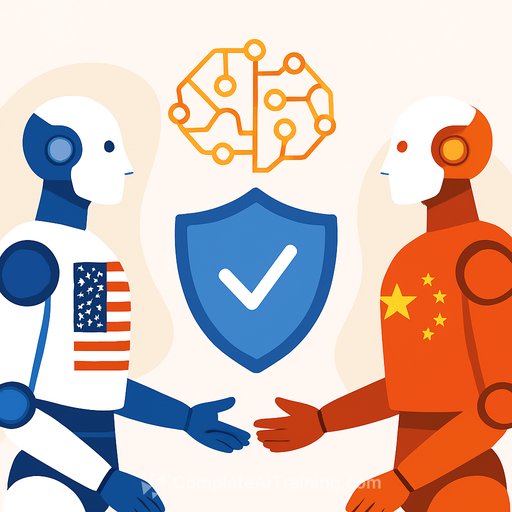Genesis Mission: A centralized AI platform for American science
President Donald Trump has signed an Executive Order launching the Genesis Mission, an AI-led initiative directed by the Department of Energy (DOE). The goal: double the productivity and impact of U.S. science and engineering within a decade through a national platform that unifies data, compute, and instruments.
The DOE frames it as a new class of scientific instrument-linking supercomputers, AI systems, quantum resources, and advanced lab equipment into one closed-loop system for discovery.
What's being built
The Genesis platform will centralize decades of federally funded datasets along with contributions from academia and industry. Those datasets will feed scientific foundation models, AI agents, and automated research workflows built for high-value tasks across disciplines.
Think of it as a shared substrate for training, inference, and experiment control-designed to shorten the time from hypothesis to result while improving reproducibility and scale.
Compute backbone and facilities
The platform will connect to two "sovereign AI" supercomputers at Oak Ridge National Laboratory (ORNL), which the DOE has named as flagships under the Trump AI Action Plan. Built by Hewlett Packard Enterprise and using AMD chips, these systems are intended to tackle national-scale challenges in energy, medicine, health, and security.
Expect integration with next-generation quantum systems and leading scientific instruments, creating end-to-end workflows that move from data collection to model training to experiment scheduling with minimal handoffs.
Department of Energy | Oak Ridge National Laboratory
Timelines and near-term milestones
- Within 4 months: Identify the initial data and model assets to onboard into the Genesis platform.
- Within 9 months: Demonstrate an initial operating capability addressing at least one national science and technology challenge.
For labs and PIs, that likely means early calls for datasets, model checkpoints, benchmarks, and instrument integrations that meet security and provenance standards.
Focus areas
- Accelerate nuclear and fusion energy R&D and modernize the grid using AI-driven workflows.
- Build a durable foundation for discovery across domains through shared models and data assets.
- Advance national security applications, including stockpile reliability and faster materials development for defense.
Why this matters for researchers
Genesis pushes toward standardized, AI-forward pipelines for experiments, simulations, and design. If you run large instruments, lead simulation campaigns, or curate critical datasets, your work may plug directly into national workflows rather than living as a siloed stack.
For method developers, this is a chance to place agents, schedulers, and foundation models closer to the data streams and instruments they serve. For program managers, it creates shared infrastructure to coordinate milestones and measure productivity gains.
What to prepare now
- Data readiness: Clear licensing, provenance, and documentation (FAIR-aligned), plus redaction for sensitive elements.
- Model assets: Publish model cards, training recipes, evaluation protocols, and safety notes for domain-specific failure modes.
- Workflows: Containerized pipelines (with reproducible seeds), clear I/O contracts, and dataset-versioning strategies.
- Security: Access control plans, auditing hooks, and policies for export control, human subjects, and proprietary data.
- Instrumentation: APIs for instrument control and streaming data; queues for autonomous or semi-autonomous experiments.
- Benchmarking: Domain-relevant, falsifiable metrics that test both capability and reliability under distribution shift.
What success will look like
- Shorter cycles from data acquisition to model updates to validated results.
- Cross-facility scheduling where supercomputers, quantum systems, and instruments coordinate without manual glue code.
- Transparent lineage: every result links back to data versions, prompts/configs, and model weights.
- Reusability: foundation models fine-tuned for specific domains become shared building blocks, not one-off efforts.
Governance and open questions
- Access and prioritization: Who gets time on the platform, and how are competing proposals scored?
- Data contribution rules: Licensing, attribution, IP treatment for academic and private-sector inputs.
- Security boundaries: Handling controlled or classified workloads alongside open science without cross-contamination.
- Evaluation standards: Agreement on domain benchmarks that reflect real scientific progress, not just leaderboard metrics.
- Publication norms: Coordinating preprints, embargoes, and code release with national-interest constraints.
Key quote from DOE leadership
Dr. Darío Gil, Under Secretary for Science and Genesis Mission Director, called the mission "an engine for discovery" intended to double R&D productivity and take on problems once seen as out of reach.
Action items for science teams
- Nominate datasets and instruments that would benefit from shared models or AI agents.
- Harden pipelines: containerize, document, and set up continuous evaluation with drift monitoring.
- Establish governance: data stewards, model owners, and review boards for safety and compliance.
- Prepare training plans so staff can work with agentic workflows, scientific foundation models, and hybrid HPC/quantum scheduling.
If your lab needs to upskill quickly for agent workflows and scientific ML, see curated programs by job role: Complete AI Training - Courses by Job.
Your membership also unlocks:




